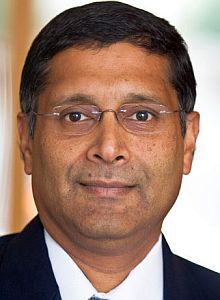 | « Back to article | Print this article |
 Chief Economic Advisor Arvind Subramanian (pictured below) says the Union Budget aims at shifting from consumption-led growth to one led by investment, and building of institutional architecture.
Chief Economic Advisor Arvind Subramanian (pictured below) says the Union Budget aims at shifting from consumption-led growth to one led by investment, and building of institutional architecture.
He spells out more on what this and related aspects would translate to, in a talk with Business Standard. Edited excerpts:
What are the three big ideas from this Budget?
First, the need for investment-led growth. It manifests in two ways.
One is public investment, which has seen a 0.3 percentage point increase or Rs 70,000 crore (Rs 700 billion).
Adding the states, it would be much more.
The other one is trying not to neglect the revival of private investment.
That is why the corporate tax vision is very important, as is the bankruptcy Bill provision. Then, of course, there is capital market development.
The second theme is balancing the interests of different groups.
If you see the Budget as a political document, it manages this balance by giving something for corporates, something for the middle class and something for people at the lower end of the spectrum.
On the latter, I would emphasise two or three things.
One is beginning of comprehensive social insurance for the poor and elderly, renewed emphasis on agriculture, where allocations have been increased on MNREGA because the farm sector incomes are stressed.
Budget 2015: Complete Coverage
The third idea is that there is a kind of vision for a strengthened institutional architecture -- a monetary policy framework agreement with the Reserve Bank of India, the public debt management agency, a new procurement law and a bankruptcy law.
 The moves on monetary policy framework, PDMA and taking over of capital controls might have ruffled RBI’s feathers.
The moves on monetary policy framework, PDMA and taking over of capital controls might have ruffled RBI’s feathers.
The finance minister is very clear that the government and RBI are partners and everything will be done by mutual consultation.
There is some rejigging but even on the restrictions on equity capital inflows, the minister has clearly said it would be done in consultation with RBI. It is not a turf thing.
In the Economic Survey, you talked about the need for compression of expenditure and the quality of that compression. Former Finance Minister P Chidambaram has said Plan expenditure is the usual metric by which the quality of government expenditure is judged and that spending has been slashed drastically in this Budget.
Part of it has to happen because of the devolution suggested by the 14th Finance Commission.
The second point is, it is not that schemes have been eliminated. Some are only being transferred to the states.
Some such as Mahatma Gandhi National Rural Employment Guarantee Scheme (the rural jobs guarantee) have not been touched; expenditure for these has been increased.
To say that reduced plan transfers reflects a decline in quality is not right.
The Budget has not only deferred the fiscal deficit target for a year but put off those on the revenue deficit for all the three years. Will this compromise the quality of the fiscal deficit, as you will have a larger one on the revenue account?
What we have said in the Economic Survey is that we should move towards the golden rule, that over the cycle you borrow basically for investment, so that the revenue deficit is close to zero.
At the central level, you have to look at the quality of adjustment -- there has been a sharp reduction in revenue expenditure in terms of share of gross domestic product.
Second, quality is also judged in terms of switching from revenue expenditure to capital expenditure.
Budget 2015: Complete Coverage
That has also happened very sharply, as revenue expenditure has come down and capital expenditure has gone up.
I think the revenue deficit has not come down enough mostly because of the 14th Finance Commission.
My calculation is that we lost 0.3-0.4 per cent of GDP because of the Commission's recommendations.
But, if you look at the consolidated level, the Centre's and the states', the revenue deficit will, in fact, decline more sharply.
The finance minister deferred the General Anti-Avoidance Rule (GAAR, for taxes) by two years, at a time when avoidance is becoming a major international issue in fora such as the G-20.
At a time when foreign investors’ sentiment is turning slowly towards us, at a time when there are concerns about an adversarial tax regime and tax terrorism, at that point of time if we introduce a GAAR, it would not be seen as the most appropriate.
There is a perception issue.
The aim is to introduce GAAR when investor sentiment has settled in our favour and as corporate tax rates come down. That would be a better time to introduce GAAR.
Would it also have made sense to align excise rates with those of service tax, to prepare the ground for the Goods and Services Tax?
That was certainly part of the budgetary discussions but it finally did not come.
I think that is the way to move forward, as come 2016 and you have to have one rate.
This year, 11.5 per cent nominal growth in GDP is giving us less than 10 per cent growth in tax receipts. For next year, the Budget has projected tax receipts to rise 15 per cent, again from the projected 11.5 per cent increase in India’s economic size?
This year’s numbers have diesel and petrol excise duty increases for only about one quarter.
So, this year, those increases fetched Rs 20,000 crore (Rs 200 billion).
If you strip out this effect, the implied buoyancy is 0.7-0.8 per cent for the next year, the same as seen in the past few years.
So, the buoyancy is the same but you are going to add Rs 70,000 crore (Rs 700 billion) from the excise duty rise on diesel and petrol, Rs 6,000-7,000 crore (Rs 60-70 billion) from the coal cess and then the service tax increase.
Add these three and you will get the numbers.
Are there any upsides to the Budget numbers and assumptions?
We were at pains to ensure the optimism or over-exuberance of the past year was not repeated.
This time, the numbers are based on much more reasonable assumptions about buoyancy and collections.
One upside could be that oil prices remain relatively low.
Budget 2015: Complete Coverage
If manufacturing picks up next year, that is a potential upside.
Of course, if real growth picks up, that will be another upside.
The Budget aims to reduce subsidies from two per cent of GDP in 2014-15 to 1.6 per cent in 2015-16. Yet, when you disaggregate the numbers, you will realise these are mainly coming from depressed global oil prices and not from food and fertiliser. What is the philosophy and what kind of policy parameters do you see which govern this decision?
I think the philosophy is that we are absolutely committed to improving the targeting and eliminating the leakages.
The way forward here is going to be what we call the JAM (Jan Dhan Yojana, Aadhaar and mobile numbers) solution and I think that is the way you are going to get rationalisation of subsidies.
Whether we see more happening without Direct Benefits Transfer is an open question. But, certainly, the philosophy is going to be not to cut these per se but to get savings by cutting leakages.
Is there any scope of extending the nutrient-based subsidy to urea?
That is part of the discussion.
There are a couple of constraints.
It is a subsidy that benefits farmers and at a time when farming becomes stressed, that is going to be a key factor.
Also, you have to take into account what is going to happen to the fertiliser industry when you rationalise the subsidies.
Are you saying that politically, extension of the nutrient-based subsidy scheme, operational for some fertilisers, to urea is not on board?
It is something the government is going to be thinking in the days ahead.
However, no clear decision has been taken, as of now.
In divestment, there is a new category -- strategic disinvestment -- set to fetch you Rs 28,500 crore (Rs 285 billion). Is this is a return of privatisation?
The Budget speech clearly said consideration would be given to both, loss-making units and strategic disinvestments.
That is a policy statement.
Whether that means drastically reduced government ownership or selling large existing minority stakes remains to be seen.
Budget 2015: Complete Coverage
For now, the policy has been laid out and the department of disinvestment will have to actually operationalise it.
This year the Budget has benefit of two committees -- expenditure management committee headed by Bimal Jalan and tax administrative reforms commission by Partharsarathi Shome. While we do find a mention in the finance minister's Budget speech about TARC being considered, is there any indication in the Budget or numbers that reflect recommendations or concerns of the Jalan panel?
We have got interim report and the government is reviewing that.
Decisions on it will be taken in the months ahead based on how to address the problem of leakages.
Tax administration reforms commission was against exemptions based on end-use. Many commentators have said the Budget has increased those.
We have over the years become an exemptions-based society.
That is why what we said on corporate taxes -- cutting the rates, reducing exemptions -- is going to be very important.
In fact, the Economic Survey has a box on eliminating CVD exemptions, which is probably the best thing we could do to realise Make in India.
We have to make progress towards that.